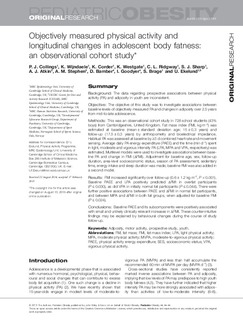| dc.contributor.author | Collings, Paul J. | |
| dc.contributor.author | Wijndaele, Katrien | |
| dc.contributor.author | Corder, Kirsten | |
| dc.contributor.author | Westgate, Kate | |
| dc.contributor.author | Ridgway, Charlotte L. | |
| dc.contributor.author | Sharp, Stephen J. | |
| dc.contributor.author | Atkin, Andrew J. | |
| dc.contributor.author | Stephen, Alison M. | |
| dc.contributor.author | Bamber, Diane | |
| dc.contributor.author | Goodyer, Ian | |
| dc.contributor.author | Brage, Søren | |
| dc.contributor.author | Ekelund, Ulf | |
| dc.date.accessioned | 2016-04-06T07:40:02Z | |
| dc.date.available | 2016-04-06T07:40:02Z | |
| dc.date.issued | 2015-04-27 | |
| dc.identifier.citation | Pediatric Obesity. 2015,11,107–114 | nb_NO |
| dc.identifier.uri | http://hdl.handle.net/11250/2384113 | |
| dc.description | © 2015 The Authors. Pediatric Obesity published by John Wiley & Sons Ltd on behalf of World Obesity.
This is an open access article under the terms of the Creative Commons Attribution License, which permits use, distribution and reproduction in any medium, provided the original work is properly cited. | nb_NO |
| dc.description.abstract | Background:
The data regarding prospective associations between physical activity (PA) and adiposity in youth are inconsistent.
Objective:
The objective of this study was to investigate associations between baseline levels of objectively measured PA and changes in adiposity over 2.5 years from mid-to-late adolescence.
Methods:
This was an observational cohort study in 728 school students (43% boys) from Cambridgeshire, United Kingdom. Fat mass index (FMI, kg m−2) was estimated at baseline (mean ± standard deviation age: 15 ± 0.3 years) and follow-up (17.5 ± 0.3 years) by anthropometry and bioelectrical impedance. Habitual PA was assessed at baseline by ≥3 d combined heart rate and movement sensing. Average daily PA energy expenditure (PAEE) and the time (min d−1) spent in light, moderate and vigorous intensity PA (LPA, MPA and VPA, respectively) was estimated. Multilevel models were used to investigate associations between baseline PA and change in FMI (ΔFMI). Adjustment for baseline age, sex, follow-up duration, area-level socioeconomic status, season of PA assessment, sedentary time, energy intake and sleep duration was made; baseline FMI was also added in a second model.
Results:
FMI increased significantly over follow-up (0.6 ± 1.2 kg m−2, P < 0.001). Baseline PAEE and LPA positively predicted ΔFMI in overfat participants (P ≤ 0.030), as did VPA in initially normal fat participants (P ≤ 0.044). There were further positive associations between PAEE and ΔFMI in normal fat participants, and between MPA and ΔFMI in both fat groups, when adjusted for baseline FMI (P ≤ 0.024).
Conclusions:
Baseline PAEE and its subcomponents were positively associated with small and unlikely clinically relevant increases in ΔFMI. These counter-intuitive findings may be explained by behavioural changes during the course of study follow-up. | nb_NO |
| dc.language.iso | eng | nb_NO |
| dc.publisher | John Wiley & sons | nb_NO |
| dc.subject | adiposity | nb_NO |
| dc.subject | motor activity | nb_NO |
| dc.subject | prospective study | nb_NO |
| dc.subject | youth | nb_NO |
| dc.title | Objectively measured physical activity and longitudinal changes in adolescent body fatness: an observational cohort study | nb_NO |
| dc.type | Journal article | nb_NO |
| dc.type | Peer reviewed | nb_NO |
| dc.subject.nsi | VDP::Medical disciplines: 700 | nb_NO |
| dc.subject.nsi | VDP::Medical disciplines: 700::Health sciences: 800 | nb_NO |
| dc.subject.nsi | VDP::Medical disciplines: 700::Health sciences: 800::Nutrition: 811 | nb_NO |
| dc.source.journal | Pediatric Obesity | nb_NO |
| dc.identifier.doi | 10.1111/ijpo.12031 | |
| dc.description.localcode | Seksjon for idrettsmedisinske fag / Department of Sports Medicine | nb_NO |
